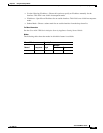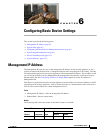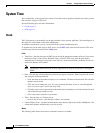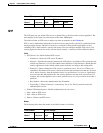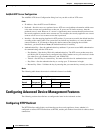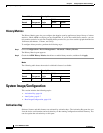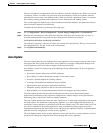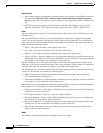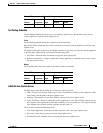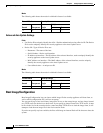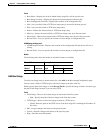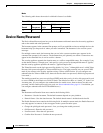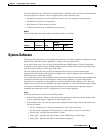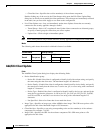
6-7
Cisco ASDM User Guide
OL-16647-01
Chapter 6 Configuring Basic Device Settings
System Image/Configuration
Features of temporary and permanent licenses combine to form the running license. When you activate
a temporary license, it overrides any previously-activated temporary license and combines with the
permanent license to create a new running license. When you activate a permanent license, it overwrites
the currently running permanent and temporary licenses and becomes the running license.
The security appliance displays any resolved conflicts between the temporary and permanent licenses
when you enter a temporary activation-key.
To update the activation key, perform the following steps:
Step 1 Go to Configuration > Device Management > System Image/Configuration > Activation Key.
Step 2 Enter the new activation key in the New Activation Key field. Enter the activation key as a four- or
five-element hexadecimal string with one space between each element, for example:
0x00000000 0x00000000 0x00000000 0x00000000
The leading 0x specifier is optional; all values are assumed to be hexadecimal. The key is not stored in
the configuration file. The key is tied to the serial number.
Step 3 Click Update Activation Key.
Auto Update
The Auto Update pane lets you configure the security appliance to be managed remotely from servers
that support the Auto Update specification. Auto Update lets you apply configuration changes to the
security appliance and receive software updates from remote locations.
Auto Update is useful in solving many of the challenges facing administrators for security appliance
management:
• Overcomes dynamic addressing and NAT challenges.
• Gives ability to commit configuration changes in one atomic action.
• Provides a reliable method for updating software.
• Leverages well understood methods for high scalability.
• Open interface gives developers tremendous flexibility.
• Simplifies security solutions for Service Provider environments.
• High reliability, rich security/management features, broad support by many products.
The Auto Update specification provides the infrastructure necessary for remote management
applications to download security appliance configurations, software images, and to perform basic
monitoring from a centralized location or multiple locations.
The Auto Update specification allows the Auto Update server to either push configuration information
and send requests for information to the security appliance, or to pull configuration information by
causing the security appliance to periodically poll the Auto Update server. The Auto Update server can
also send a command to the security appliance to send an immediate polling request at any time.
Communication between the Auto Update server and the security appliance requires a communications
path and local CLI configuration on each security appliance.
The Auto Update feature on the security appliance can be used with Cisco security products, as well as
products from third-party companies that want to manage the security appliance.



